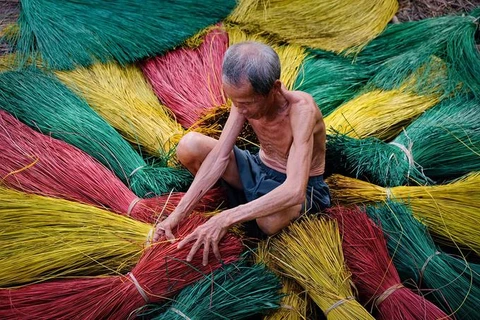Hanoi (VNS/VNA) - The patterns, colours and technique of traditional Vietnamese mat weaving are on display in an online exhibition through the artworks of Pham Hong Linh.
Due to the pandemic, the exhibition was held online and can be seen at areacodeartfair.com/pham until August 31.
Visual artist and designer Linh created a video illustrating the weaving process with the sound recorded from the loom. She made a digital rendering of the traditional Vietnamese reed mat weaving process.
Through the exhibition Area Code, the artist said she wants to bring Vietnamese artisanship to a wider audience.
Nguyen Ngọc, a Vietnamese viewer of the exhibition, said she was in awe of Linh's artworks.
“Vietnamese families always have at least one mat to use all year round,” Ngoc said.
“A big mat is a place my family gather to have a meal or take a nap in summer. However, I have never known how it is woven.”
“Thanks to Linh's digital artwork, she codes them actually, I now understand a sophisticated handicraft technique behind a mat,” Ngoc said.
The artworks are inspired by the trade of weaving mat in Cam Ne village, the central province of Quang Nam, 14km from Da Nang city.
The village was renowned for its colourful and meticulous hand-woven reed mats that were favoured by kings of the Nguyen Dynasty in the 19th century. The mat took a day to weave, reed by reed, and had to be performed by two people using a simple wooden loom. The rustling sound of reeds and the creaking rhythm of the wooden loom were the heartbeats of the village. Now, very few artisans maintain the craft.
“When I was a child growing up in Vietnam, like many households back then, my family used to gather around for dinner on a woven reed mat,” Linh said. “Sometimes the dinner would go on for so long that the reeds left imprints on my skin, a memento of sorts for the time shared together."
“Reed mat weaving is a Vietnamese traditional handicraft but has now become a vanishing practice due to industrialisation and a shifting lifestyle. This exhibition is a manifestation of nostalgia, the passing of traditions, and a desire to grasp onto a craft that situates my memory of home.”
“Cam Ne mats are different from those that originated from other regions because they are colourful and take much time and effort to make. I want to promote the value of these mats and honour the art of the makers,” she said.
Linh is a Boston-based artist and designer whose work focuses on experimental communication via the convergence of art, technology, and culture. Currently, she is designing self-driving cars.
She holds a BA of Economics from Brown University, an MA in Visual Communication from the Royal College of Art (UK) and is an alumnus of the School of Poetic Computation. She is interested in creating interactive and sensorial environments to connect and communicate with others. Some of her works include explorations of our emotional attachment to smartphones, biases behind facial recognition and crime prediction algorithms, and using code to create visual poetry.
After 10 years away from Vietnam, Linh hopes to use the skills she’s learned since leaving to remember, reimagine, and recreate her personal experience bounded by the two worlds.
All profits from selling artworks will be donated to artisans in Cam Ne village./.
VNA























